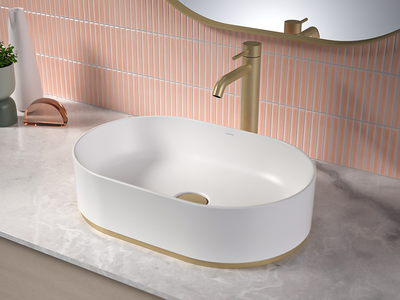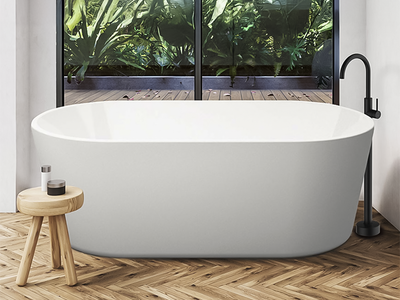The Renovator’s Guide to the Best Bathroom Vanities (2025)
A well-chosen vanity sets the tone for both the style and functionality of your bathroom.
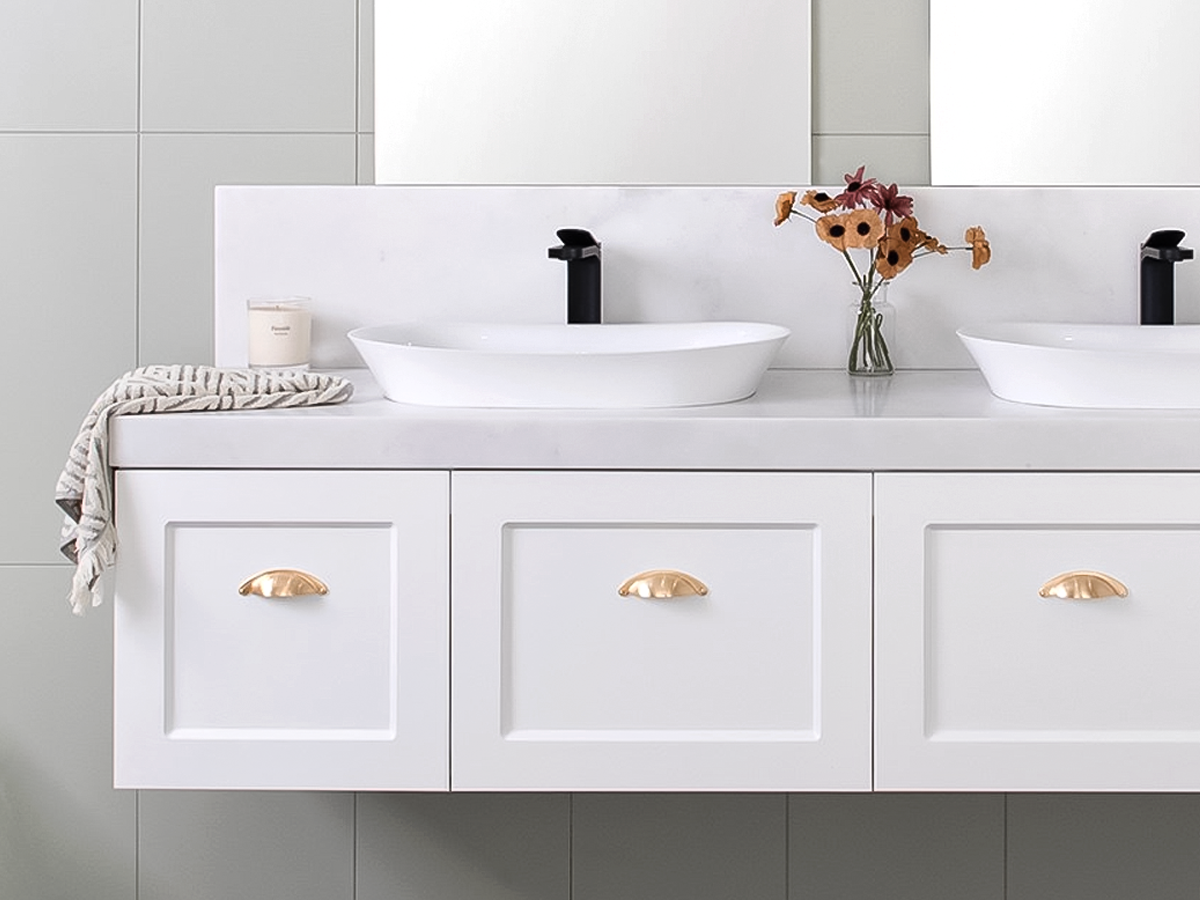
This guide offers practical insights, side-by-side comparisons, and expert-backed recommendations to help you choose the right vanity that suits your space, storage needs, and design goals.
Learn how size, installation types and colour impact daily use and long-term maintenance can help shape the perfect bathroom fit-out.
How Much Should You Budget for a Vanity?
Set aside around 10-15% of your total bathroom renovation budget for your vanity.
This gives you enough room to balance design impact with everyday function, without compromising storage or layout flexibility.
While it's tempting to focus on looks alone, the best choice considers how much storage you need, who’s using the space, and how the vanity integrates with your plumbing and floor plan. Wall-hung units cost more to install but free up floor space. Floor-standing vanities are easier to retrofit and offer extra internal volume.
💎 Buildmat Pro Vanity Budgeting Tip
Bathroom vanities shape how you move through the space. Choose yours early in your renovation process to make sure your tap, basin, waste outlet and cabinetry all align before rough-ins and waterproofing are locked in.
What Size Vanity Works Best for Your Bathroom Layout?
The best vanity size depends on your floor plan, clearance zones, and how the space is used. 900mm suits most standard bathrooms, while compact spaces may need 600mm or smaller.
Wider vanities (1200mm+) offer more storage and bench space but require careful planning to avoid crowding showers, doors or toilets. Always allow enough room to stand comfortably in front of the basin, open drawers fully, and move through the space without obstruction.
If you're renovating a shared or family bathroom, a double vanity can reduce traffic and improve flow. For a powder room vanity or ensuite, a slimline wall-hung vanity can save space without sacrificing function.
Measure twice, especially around door swings, tap clearance and plumbing points, before choosing a final width.
465mm Vanities
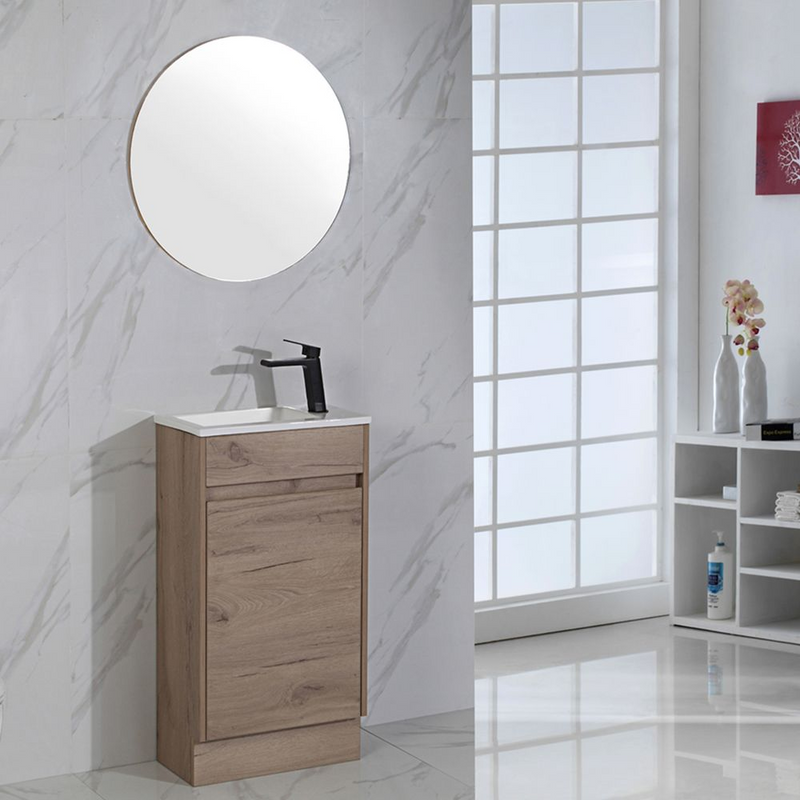
WHY A 465MM VANITY WORKS BEST FOR POWDER ROOMS OR TIGHT SPACES
A 465mm vanity is ideal when you need basic function without taking up floor space. It fits perfectly in powder rooms, small ensuites, or narrow bathroom corners where a full-sized vanity won’t fit. You’ll get just enough room for soap, hand towels, and a few essentials, while keeping the layout open and accessible.
WHAT TO CONSIDER BEFORE CHOOSING A 465MM VANITY
465mm vanities offer limited bench and drawer space, so they’re best for bathrooms that don’t require daily storage. If floor-mounted, ensure there’s enough toe space and plumbing clearance. A wall-hung model can help open up the room visually, but check that your wall is strong enough for mounting.
600mm Vanities
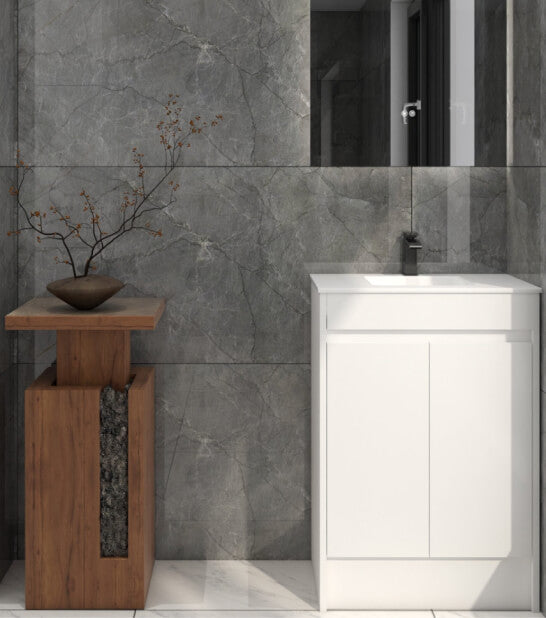
WHY A 600MM VANITY SUITS SMALL BATHROOMS AND COMPACT RENOVATIONS
A 600mm vanity is compact but functional, offering enough storage for one person’s daily essentials. It works well in small bathrooms, apartments, or secondary spaces where space is limited but performance still matters. It strikes a balance between minimal footprint and practical storage.
WHAT TO CONSIDER BEFORE CHOOSING A 600MM VANITY
600mm vanities offer basic storage and limited surface space, so plan for wall storage or organisers. Ensure at least 700mm of front clearance, and check for nearby doors or toilets that might obstruct access. Wall-hung models can help visually declutter the room, especially in tight floor plans.
750mm Vanities

WHY A 750MM VANITY IS GREAT FOR GUEST BATHROOMS OR LIGHT DAILY USE
A 750mm vanity offers more surface and storage space without crowding your layout. It’s ideal for guest bathrooms, compact family setups, or bathrooms that need a bit more functionality than a 600mm unit, while still preserving wall space.
WHAT TO CONSIDER BEFORE CHOOSING A 750MM VANITY
A 750mm vanity is still a single-user setup, so it may not suit heavily used family bathrooms. Ensure drawers or cupboard doors have room to open fully. If wall-mounting, confirm stud placement and brace the wall if needed. Above-counter basins may reduce usable bench space at this size.
900mm Vanities
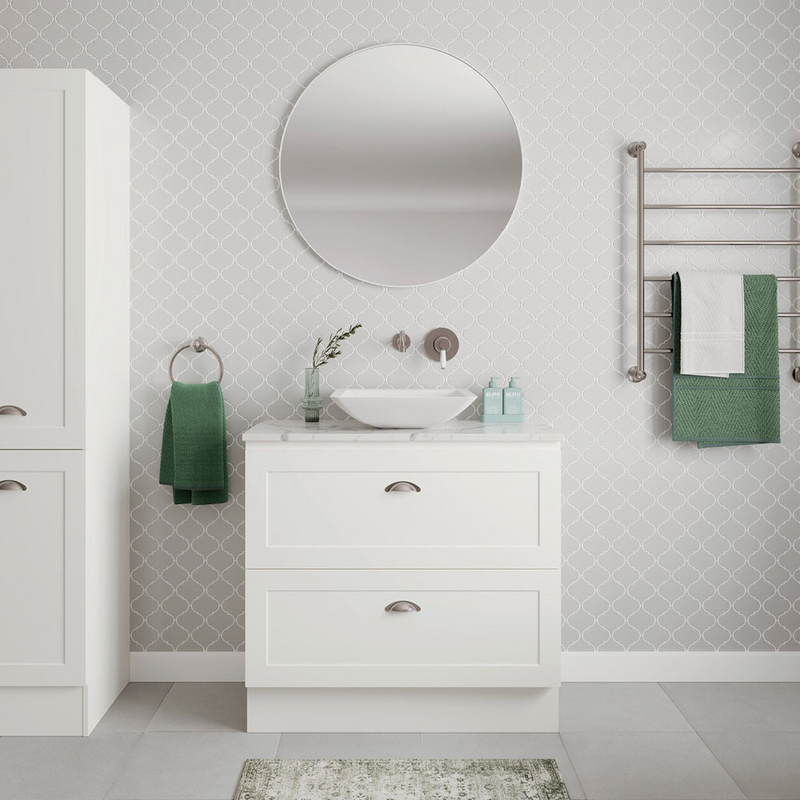
WHY A 900MM VANITY WORKS FOR MOST STANDARD BATHROOM LAYOUTS
A 900mm vanity provides a comfortable amount of storage and bench space for daily use. It’s one of the most popular sizes for family homes, offering functionality without dominating the room. It suits most standard bathroom footprints and works well in both new builds and renovations.
WHAT TO CONSIDER BEFORE CHOOSING A 900MM VANITY
A 900mm vanity needs adequate clearance (ideally 800–900mm in front) for comfortable access. It may feel bulky in a very narrow ensuite, so consider a wall-hung option to free up floor space. Be sure to measure wall-to-wall space carefully, especially if fitting between other fixtures.
1200mm Vanities
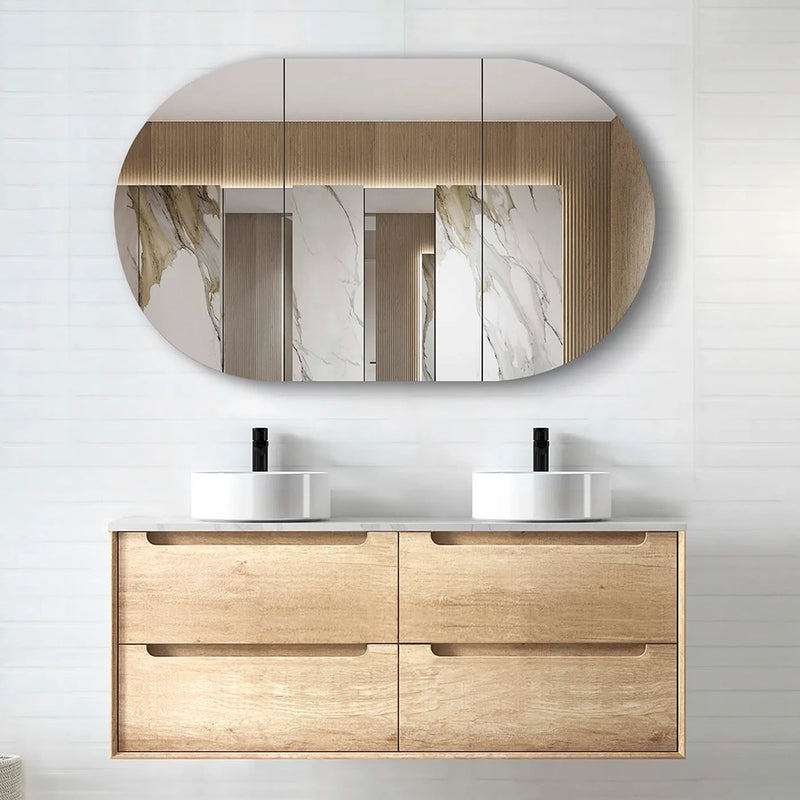
WHY A 1200MM VANITY SUITS COUPLES OR SHARED BATHROOMS
A 1200mm vanity gives you ample storage and counter space for two users without overwhelming the room. It’s large enough for shared use, and some models even support dual basins in a compact format. Great for main bathrooms where storage and usability need to scale up.
WHAT TO CONSIDER BEFORE CHOOSING A 1200MM VANITY
A 1200mm vanity may need adjustments to your plumbing or mirror layout, especially if adding two basins. Check door and drawer clearance against nearby fittings, and confirm that the wall width allows enough breathing room. Floating models can help keep larger vanities from feeling heavy in medium-sized rooms.
1500mm Vanities
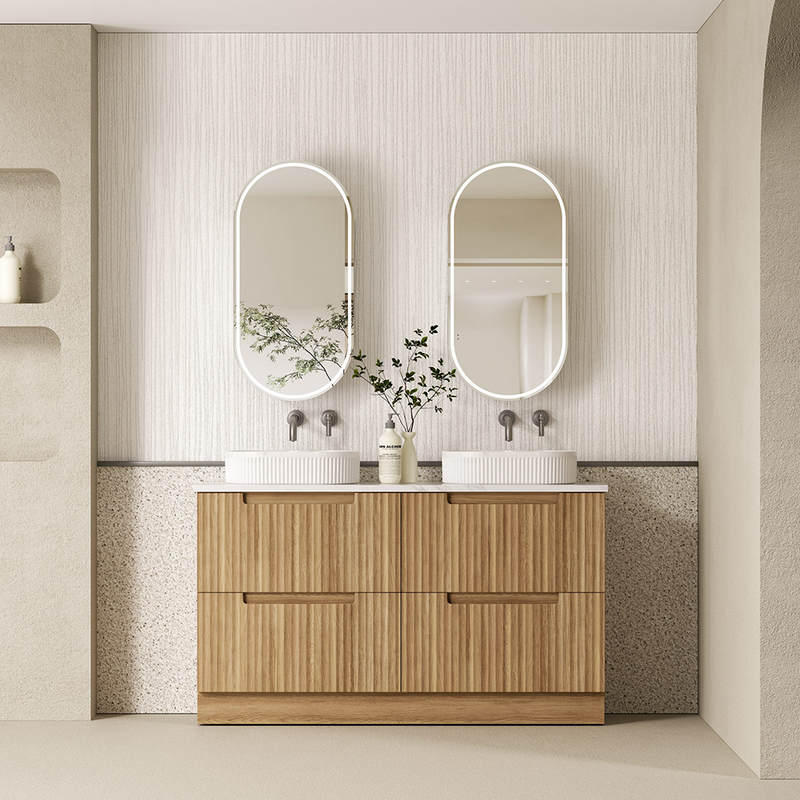
WHY A 1500MM VANITY IS A SMART UPGRADE FOR BUSY BATHROOMS
A 1500mm vanity offers generous storage and bench space, making it ideal for family bathrooms. It can accommodate dual basins while leaving room for shared counter space, giving multiple users a practical and clutter-free experience.
WHAT TO CONSIDER BEFORE CHOOSING A 1500MM VANITY
A 1500mm vanity takes up a significant stretch of wall, so be sure it won’t crowd the toilet or shower zone. Measure your space carefully, especially if planning two basins, and factor in where your plumbing rough-ins fall. The extra width also calls for proportional lighting and mirror choices to maintain visual balance.
1800mm Vanities
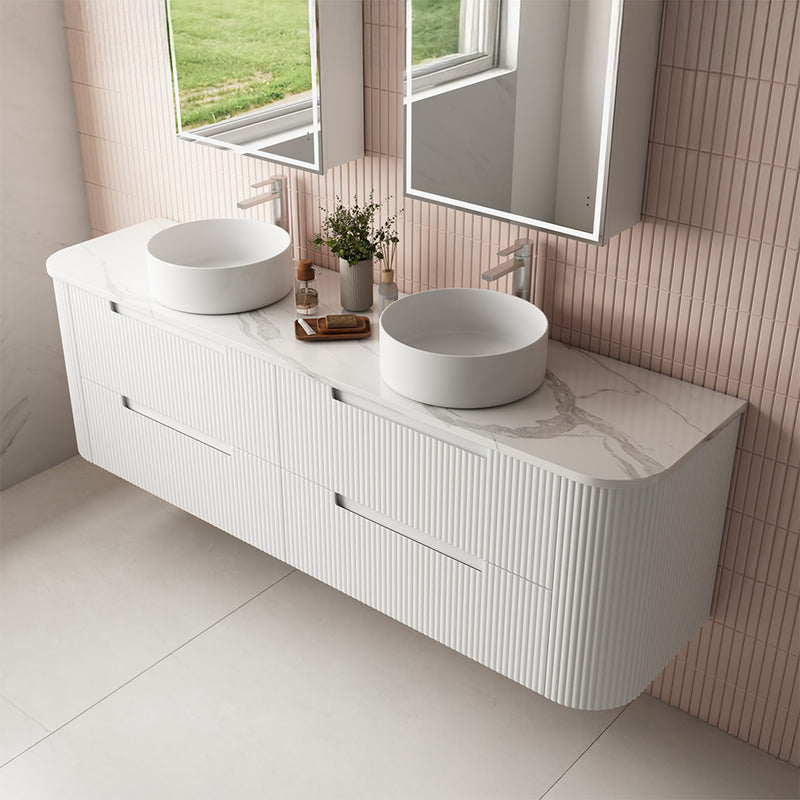
WHY A 1800MM VANITY IS PERFECT FOR MASTER ENSUITES AND LUXURY BATHROOMS
An 1800mm vanity offers maximum storage, dual sinks, and a premium finish that elevates the entire room. It’s ideal for master bathrooms or large layouts where space isn’t a constraint, giving you full-width functionality and plenty of room to spread out.
WHAT TO CONSIDER BEFORE CHOOSING A 1800MM VANITY
An 1800mm vanity requires more planning, especially around plumbing, mirror alignment, and floor clearance. Be sure to leave enough space in front (at least 900mm) and around the sides for access. The size and weight also mean that wall mounting requires solid support. Coordinate with wide mirrors or lighting that match the scale of the vanity for best results.
How Vanity Installation Style and Shape Affect Functionality
The style and shape of your vanity impact storage, cleaning, and how easily you move through the space.
Wall-hung vanities make bathrooms feel more open and modern. Freestanding vanities are easier to install and offer more storage. Curved vanities reduce sharp edges and improve flow in tight or high-traffic areas.
Choosing the right vanity format can make your layout feel smoother and more usable.
💎 Buildmat Pro Installation Tip
Working with a compact or high-traffic bathroom? Curved or wall-hung vanities open up movement and make cleaning easier. Renovating an older space with fixed plumbing? Freestanding vanities simplify installation and give you more room to store the everyday clutter.
Wall-Hung Vanities
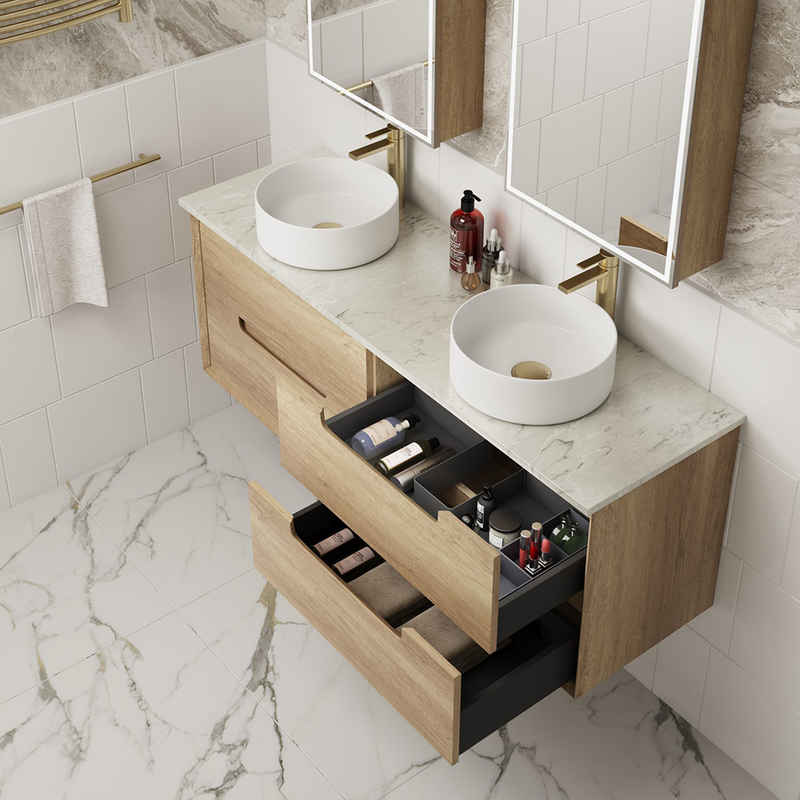
WHY WALL-HUNG VANITIES CREATE A CLEAN, SPACIOUS LOOK IN SMALLER BATHROOMzs
Wall-hung vanities are mounted directly to the wall, creating a floating effect that opens up the floor and makes the room feel larger. They suit contemporary bathrooms where a minimalist, uncluttered finish is key.
By lifting the unit off the ground, you not only enhance visual space but also make floor cleaning easier, especially in tight bathrooms as an ensuite vanity. This style works particularly well in smaller layouts where floor space is limited or where a sense of openness is important.
WHAT TO CONSIDER BEFORE CHOOSING A WALL-HUNG VANITY
Wall-hung vanities require a load-bearing wall or reinforced bracing to support the weight of the unit and basin. Plumbing may need to be re-routed to suit the elevated position, so it’s best suited to full renovations or new builds where services can be adjusted early. Also consider basin height: wall-hung units allow more flexibility, but the finished height still needs to be practical for all users.
Freestanding Vanities

WHY FREESTANDING VANITIES ARE IDEAL FOR RETROFITS AND FAMILY BATHROOMS
Freestanding vanities sit directly on the floor, offering generous storage and a more traditional installation process. They’re a practical choice for renovations, especially in older homes where floor waste and wall structure may limit other options.
These vanities come in a range of styles, from classic to contemporary, and often include deeper drawers or cupboards than their wall-hung counterparts. Their sturdy, grounded feel suits family bathrooms and high-use spaces.
WHAT TO CONSIDER BEFORE CHOOSING A FREESTANDING VANITY
Freestanding vanities are easier to install, especially when you're working with existing plumbing. However, because they touch the floor, they can be harder to clean around and may show more wear in wet zones.
If placing against a wall, ensure your skirting tiles or wall angles allow a flush fit. And if your bathroom is compact, consider whether a freestanding design may make the space feel more enclosed.
Curved Vanities
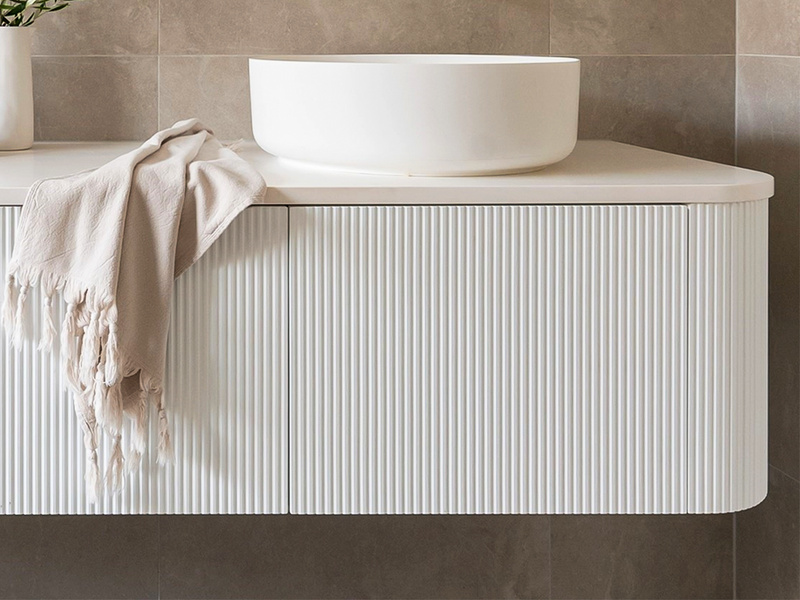
WHY CURVED VANITIES IMPROVE FLOW AND SAFETY IN COMPACT BATHROOMS
Curved vanities feature softened edges and rounded fronts, making them ideal for small or high-traffic bathrooms where bumping into corners is a concern. They’re a great option for family homes, powder rooms, or walk-through spaces where traditional rectangular vanities might feel sharp or awkward. The organic form also adds visual softness and a point of difference in more design-driven interiors, with some also coming in a fluted vanity design.
WHAT TO CONSIDER BEFORE CHOOSING A CURVED VANITY
Curved vanities often have less internal space than straight-edged models, so storage capacity may be slightly reduced. Finding compatible basins or mirror shapes may also require a more considered design approach.
Since most curved vanities are wall-hung, you’ll need to factor in the same support and plumbing considerations as other floating units. Always check dimensions carefully (particularly depth at the widest point) to ensure your layout remains functional.
How to Choose the Best Vanity Colour for Your Bathroom
The best vanity colour complements your overall palette, suits your lighting conditions, and reflects how you want the space to feel.
If in doubt, start with the room’s anchor elements, like floor tiles, wall paint, benchtop material, and choose a vanity colour that complements rather than competes. Lighter tones like white or oak help small bathrooms feel open and clean, while darker shades like black add contrast and sophistication in larger or design-led spaces.
If your bathroom gets limited natural light, steer clear of very dark finishes, which can make the room feel smaller or flatter. Think about material texture too: timber-look finishes add warmth, while satin or gloss fronts offer a cleaner, more contemporary edge. For timeless appeal, stick to neutrals.
Black Vanities
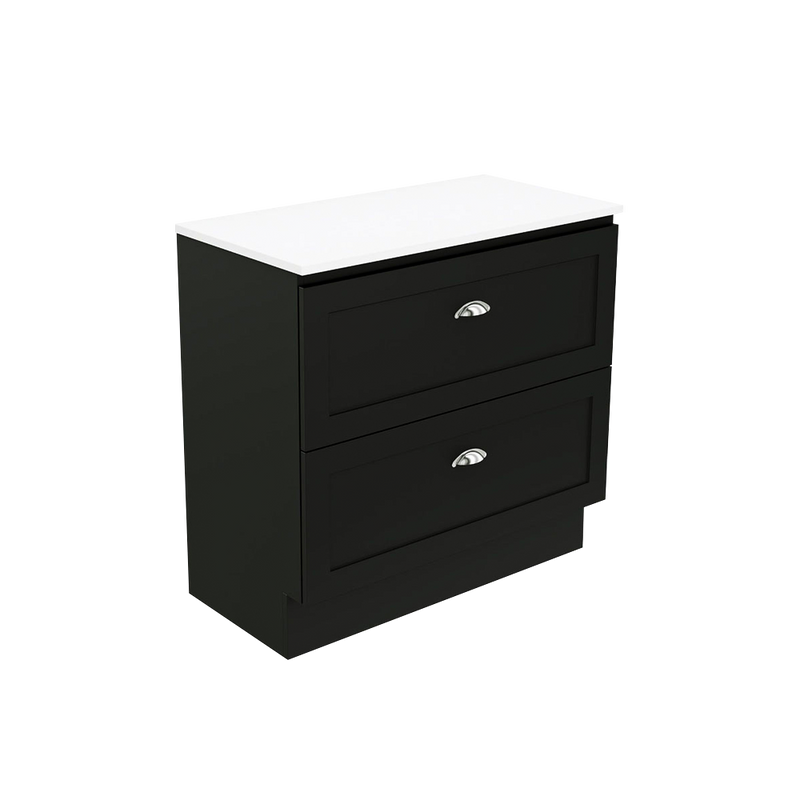
WHY BLACK VANITIES MAKE A BOLD, MODERN STATEMENT IN THE BATHROOM
Black vanities are best for bathrooms that lean toward a modern, minimalist, or industrial style. They add contrast, depth, and a strong design anchor when paired with white tiles or brushed metal fixtures. A matte or satin finish conceals fingerprints and adds sophistication without overwhelming the room. In the right setting, black can feel crisp, elegant, and surprisingly timeless.
WHAT TO CONSIDER BEFORE CHOOSING A BLACK VANITY
Black vanities can visually shrink a space, especially in bathrooms with low light or limited floor area. If your bathroom requires a small vanity, pair it with light walls, a large mirror, or skylights to maintain balance. Scratches or hard water marks may show more clearly on flat matte finishes, so opt for high-quality, smudge-resistant materials. Black works best as a contrast piece, so keep surrounding finishes simple to let it shine.
White Vanities
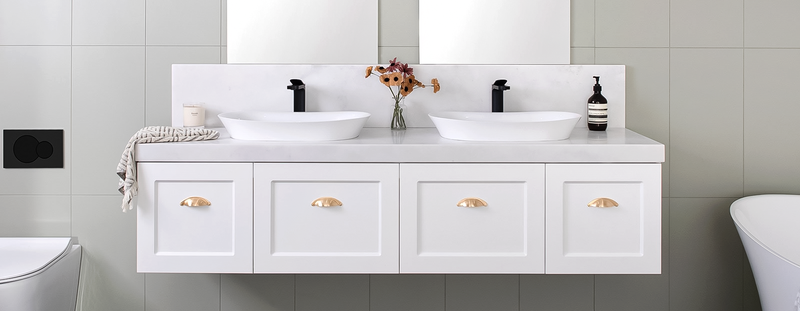
WHY WHITE VANITIES ARE A SAFE, VERSATILE CHOICE FOR ANY BATHROOM
White vanities suit almost every bathroom layout and design style, making them the most adaptable and timeless option. They reflect light, open up smaller rooms, and pair effortlessly with any tile or tapware finish. Whether you’re after a minimalist look or a classic coastal style, a white vanity gives you flexibility and longevity in your design.
WHAT TO CONSIDER BEFORE CHOOSING A WHITE VANITY
White vanities can show dust, spills, or toothpaste splatter more easily, so regular cleaning is key. Gloss finishes can highlight surface imperfections over time, while satin or textured finishes tend to be more forgiving. For families or high-traffic bathrooms, choose a durable material that resists yellowing, chipping or moisture damage. When in doubt, white keeps things clean, calm, and resale-friendly.
Timber Vanities
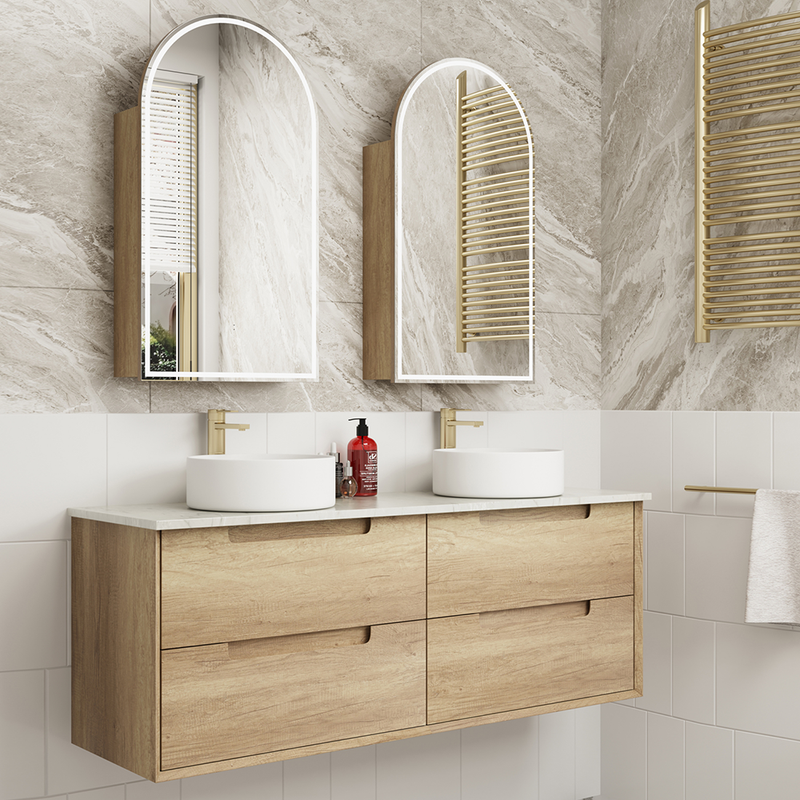
WHY TIMBER VANITIES ADD WARMTH AND TEXTURE TO BATHROOM SPACES
Timber vanities are perfect for softening modern bathrooms or adding warmth to cool tile palettes. They bring a natural, organic feel and work across a range of styles, like contemporary or as a Hamptons-style vanity. Available in light oak, mid-toned walnut, or deeper woodgrains, timber-look finishes help bathrooms feel more inviting, grounded, and tactile.
WHAT TO CONSIDER BEFORE CHOOSING A TIMBER VANITY
Timber finishes can vary in tone and grain, so be sure to choose one that complements your tile and benchtop. Lighter tones feel airy and Scandi, while darker timbers add richness and drama. Avoid clashing with overly warm or cool tile colours. Some timber-look vanities use textured laminates, which offer durability with less upkeep than real timber, ideal for family bathrooms or wet zones.
Must-Have Accessories to Complement Your Vanity
The right bathroom accessories can enhance how your vanity looks, functions, and wears over time. Whether you're upgrading a family bathroom or refining a minimalist ensuite, small add-ons can make daily use smoother and help extend the life of your setup.
Start with your basin and matching mixers, basin waste and mirror frame to elevate the finish. For larger vanities, a mirrored shaving cabinet can double your storage without taking up extra wall space.
Buildmat’s vanity accessories are designed to coordinate with your finish, streamline your storage, and support smarter bathroom design from the inside out.
Browse Buildmat’s Curated Vanity Accessory Range
How to Clean and Maintain Your Vanity
Proper vanity care keeps your bathroom looking polished, hygienic, and high-functioning for years to come. With a few regular habits, you can prevent water damage, surface wear, and mould buildup.
Daily Cleaning
Wipe down the vanity top with a soft cloth and a pH-neutral cleaner after use. Focus on areas around the basin, tapware, and drawer edges where water tends to collect. For matte or textured finishes, use a damp microfiber cloth to lift dust and avoid streaking. On gloss or painted surfaces, avoid acidic sprays or abrasive pads that can dull the finish over time.
Deep Cleaning
Once a week, clear the bench and clean all surfaces thoroughly, including drawer handles, splashbacks, and under-mount lips. Use a soft-bristle brush or cloth to get into edges and seams, particularly where the basin meets the benchtop. For timber-look finishes, lightly dampen your cloth and follow with a dry wipe to prevent moisture damage.
Don’t forget to clean around the basin, waste and overflow hole if present. These areas can trap grime and soap residue.
Avoid Harsh Chemicals
Steer clear of bleach, ammonia, or abrasive pastes, especially on painted, laminate, or timber finishes. These can strip protective coatings, cause swelling, or leave permanent marks. For stubborn grime, use a gentle cream cleanser labelled safe for cabinetry or benchtop use. Always patch-test first if you’re unsure.
Routine Checks
Once a month, inspect inside drawers and cupboards for signs of water damage, mould, or leaks. Check the silicone seal around your basin and along wall joins and replace or reseal if it’s peeling, cracked, or showing signs of mildew. If you have a wall-hung vanity, confirm it remains flush with the wall and hasn’t shifted from moisture or wear.
Protection Accessories
Drawer organisers and basin trays help reduce spills and protect internal surfaces from moisture damage. If your vanity is wall-hung, consider a bottle trap cover to conceal plumbing and maintain a tidy aesthetic. Use felt bumpers or drawer liners to prevent scratches on high-use surfaces.
Your perfect bathroom is closer than you think.
Choosing the right vanity means getting the size, finish, and functionality right for your daily routine. With the right combination of form and function, your vanity becomes a standout feature that lifts your entire bathroom design.
Still comparing options? Start by browsing Buildmat’s full vanity collection to weigh up sizes, finishes, and installation styles or chat with our team for expert, layout-specific advice.
Frequently Asked Questions
FAQs
It depends on the model. Some vanities come with an integrated top and pre-drilled holes, while others are sold as separate cabinets and benchtops so you can customise your basin and tapware position. Always check the product specs before purchase.
Yes, but installation may require specialised fixings and tools. If you're wall-mounting into brick or concrete, consult your builder or installer to ensure proper anchors are used. Pre-planning for plumbing recesses and wall chases is also important with masonry walls.
Technically, yes, but you’ll sacrifice bench space. Double basins in a 1200mm vanity can feel cramped and may require smaller-than-standard basins. If two users need simultaneous access, consider going up to 1500mm+ or pairing a 1200mm vanity with a wide mirror and offset basin to maximise shared use.
Finger-pull vanities have integrated channels for a clean, seamless look, while handle vanities feature knobs, bars or pulls. Finger-pull options are easier to wipe down and suit minimalist spaces, but handles offer more grip, especially helpful in kids’ bathrooms or for elderly users.
































































































































































































































